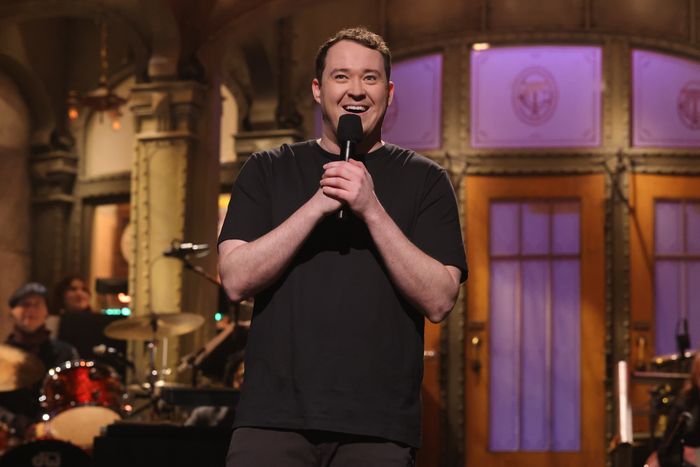
Shane Gillis made his return to Saturday Night Live last weekend, now in the role of host five years after being fired from his very brief stint as a cast member due to the series of racist, homophobic, and sexist jokes he had made on podcasts. In the days since, the discourse on social media and in comments sections has fallen into a pattern that’s become predictable when quote-unquote offensive comedy is involved. Critics say he struggled through a monologue that was “tone-deaf” and “mean,” while his fans argue he “crushed” by forcing this uptight audience to hear some bad words. But it really isn’t a matter of free speech, political correctness, or even cancel culture. Shane Gillis simply bombed.
Gillis is not the first person to host SNL and attempt to do potentially controversial material. Louis C.K. talked about child molestation in 2015. Chris Rock talked about how he’d never go into the Freedom Tower in 2014. Dave Chappelle, after the 2016 election, talked about how he was going to give Donald Trump a chance. Bill Burr railed against white women in 2020, and in 2013, Zach Galifianakis said the joke, “I like dark comedies. That’s why I like the Wayans brothers.” Just a year ago, Woody Harrelson used his monologue to offer up some COVID-19 conspiracies. Some of those hosts’ monologues generated backlash the next day, but they all killed on the night. For better or worse, those hosts got away with it. That’s the art — and it’s what Gillis failed to do.
Gillis’s monologue made me think of Anthony Jeselnik’s 2023 appearance on Theo Von’s This Past Weekend podcast. “All these comics now, it’s like almost the point is to get in trouble. It’s like, ‘Why are you giving me shit? I’m a comic. I’m allowed to say whatever I want,’” Jeselnik explained. “That’s wrong, as far as I’m concerned.” He then offers a quote from Andy Warhol: “Art is getting away with it.” You can talk about sensitive issues, like sexuality or disabilities, but the audience needs to leave happy. “That’s art,” Jeselnik added. “Otherwise, you’re just a troll.”
Some fans online were just excited that Gillis said the R-word and “gay” on SNL. Others seemed to relish that the audience and band behind him didn’t enjoy it. They celebrated him being a troll on the biggest stage. But that’s a misread on Gillis’s comedy. He’s not a troll comedian. He doesn’t just throw inflammatory words into his act for shock or to get a rise out of his audience. Rather, he’s a getting-away-with-it comedian — he has an ability to get audiences to laugh at ideas they don’t agree with or words they don’t agree with being used through self-deprecation and a personal perspective. And that ability to walk the line is what has earned him fans from all over the comedy spectrum.
Pulling off that sensitive dance demands that the audience trust the comedian, and part of that trust comes from a sense of assuredness that the comedian knows what they’re doing. Part of the reason Gillis’s material doesn’t go over as well on SNL as it does in his stand-up specials is that, during his SNL monologue, he’s visibly nervous onstage. He awkwardly has to wait a couple seconds too long for someone to bring him the mic then stammers through his first joke, which is a vague acknowledgement of the controversy around his 2019 SNL hiring and firing. The joke doesn’t work — probably because fewer people in the audience actually know the details of what happened than the joke would suggest — and all Gillis does by telling people not to Google something is create a distracting intrigue and off-kilter energy.
This energy extends into his next bits. When he delivers the punch line (around the 1:10 mark) during his high-school football-coach joke, even though you hear laughter in the clip, Gillis awkwardly pauses, laughs, and says “All right” to himself. The set continues, and he gets the occasional punch line pop but fails to build the rolling laughter found in any good stand-up set. Then there’s the moment where he points to his father in the audience and mocks how he’s a volunteer assistant girls-high-school basketball coach. It sounds like people in the studio are laughing, but Gillis reacts to the camera like it fully bombs, saying, “I thought that was funny.” Later in the set, he says, “I can see everyone not enjoying it. Just the most nervous I’ve ever been.” It’s surprising no one told him beforehand to act like he’s killing no matter what. Part of it’s probably a lack of confidence; most episodes of SNL start with a person literally doing stand-up for the first time, and it works because stars know how to be poised on TV. This is the risk of asking someone to host who has no TV experience. (Gillis was even more uncomfortable during the live sketches, where he struggled to read cue cards.)
Gillis’s early monologue stumbles were for the safe, easy stuff that was supposed to get the audience onboard for his dicier material later, but how he plays it forces him in the position of trying to win the audience back. But he clearly is rattled. When he arrives at the Down syndrome section and it doesn’t get the reaction he expects, he defensively jokes, “Look, I don’t have any material that could be on TV.” It’s similar to Jo Koy blaming his Golden Globes writers during his monologue, but in this case, Gillis is blaming himself. It’s not that the jokes were necessarily bad — Gillis just didn’t succeed in his attempt to tell them to this audience. Unlike the Globes, the SNL audience is excited to see comedy, so all the host needs to do with the monologue is convey why they should be there and that it’s going to be a fun show. And Gillis both explicitly and implicitly told the audience he shouldn’t be and it wasn’t.


